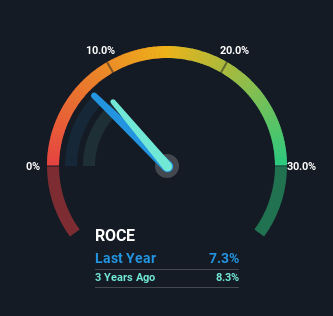- United States
- /
- Machinery
- /
- NasdaqGS:ERII
Energy Recovery (NASDAQ:ERII) Has Some Way To Go To Become A Multi-Bagger
To find a multi-bagger stock, what are the underlying trends we should look for in a business? Typically, we'll want to notice a trend of growing return on capital employed (ROCE) and alongside that, an expanding base of capital employed. Put simply, these types of businesses are compounding machines, meaning they are continually reinvesting their earnings at ever-higher rates of return. However, after investigating Energy Recovery (NASDAQ:ERII), we don't think it's current trends fit the mold of a multi-bagger.
Return On Capital Employed (ROCE): What Is It?
For those that aren't sure what ROCE is, it measures the amount of pre-tax profits a company can generate from the capital employed in its business. To calculate this metric for Energy Recovery, this is the formula:
Return on Capital Employed = Earnings Before Interest and Tax (EBIT) ÷ (Total Assets - Current Liabilities)
0.073 = US$17m ÷ (US$249m - US$20m) (Based on the trailing twelve months to June 2024).
So, Energy Recovery has an ROCE of 7.3%. Ultimately, that's a low return and it under-performs the Machinery industry average of 14%.
See our latest analysis for Energy Recovery

Above you can see how the current ROCE for Energy Recovery compares to its prior returns on capital, but there's only so much you can tell from the past. If you'd like, you can check out the forecasts from the analysts covering Energy Recovery for free.
The Trend Of ROCE
There are better returns on capital out there than what we're seeing at Energy Recovery. Over the past five years, ROCE has remained relatively flat at around 7.3% and the business has deployed 44% more capital into its operations. Given the company has increased the amount of capital employed, it appears the investments that have been made simply don't provide a high return on capital.
The Key Takeaway
In summary, Energy Recovery has simply been reinvesting capital and generating the same low rate of return as before. Yet to long term shareholders the stock has gifted them an incredible 100% return in the last five years, so the market appears to be rosy about its future. Ultimately, if the underlying trends persist, we wouldn't hold our breath on it being a multi-bagger going forward.
On a separate note, we've found 2 warning signs for Energy Recovery you'll probably want to know about.
For those who like to invest in solid companies, check out this free list of companies with solid balance sheets and high returns on equity.
Valuation is complex, but we're here to simplify it.
Discover if Energy Recovery might be undervalued or overvalued with our detailed analysis, featuring fair value estimates, potential risks, dividends, insider trades, and its financial condition.
Access Free AnalysisHave feedback on this article? Concerned about the content? Get in touch with us directly. Alternatively, email editorial-team (at) simplywallst.com.
This article by Simply Wall St is general in nature. We provide commentary based on historical data and analyst forecasts only using an unbiased methodology and our articles are not intended to be financial advice. It does not constitute a recommendation to buy or sell any stock, and does not take account of your objectives, or your financial situation. We aim to bring you long-term focused analysis driven by fundamental data. Note that our analysis may not factor in the latest price-sensitive company announcements or qualitative material. Simply Wall St has no position in any stocks mentioned.
About NasdaqGS:ERII
Energy Recovery
Designs, manufactures, and sells energy efficiency technology solutions in the United States, North, South and Latin America, the Middle East, Northern Africa, Asia, and Europe.
Flawless balance sheet with reasonable growth potential.
Similar Companies
Market Insights
Community Narratives





